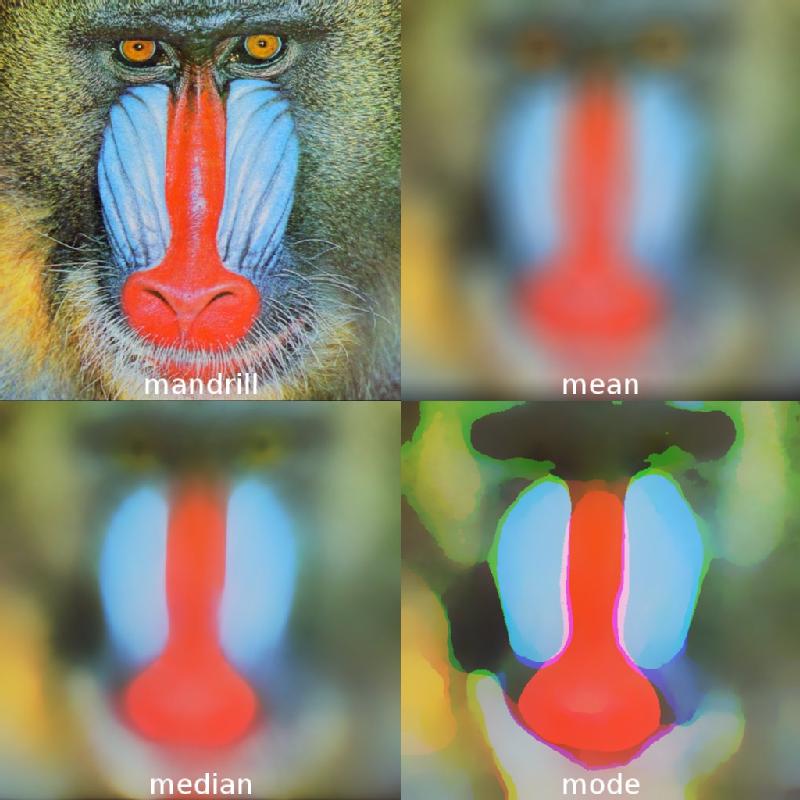Mode Filter
Sherman E. Lo, 2020
The mode filter is an edge-preserving smoothing filter by taking the mode of the empirical density. This may have applications in image processing such as image segmentation. The filters were also implemented on a GPU using CUDA and JCuda. This speeds up the filtering by a huge margin.
Where appropriate, please cite the thesis Lo, S.E. (2020). Characterisation of Computed Tomography Noise in Projection Space with Applications to Additive Manufacturing. PhD thesis, University of Warwick, Department of Statistics.
Please see the GitHub repository for more information.

The mode filter applied on the Mandrill test image. Top left to top right, bottom left to bottom right: mandrill test image, then the mode filter with radius of 2, 4, 8, 16, 32, 64, 128 applied.
The mode filter is an image filter much like the mean filter and median filter. They process each pixel in an image. For a given pixel, the value of the pixel is replaced by the mean or median over all pixels within a distance r away. The mean and median filter can be used in ImageJ, it results in a smoothing of the image. 
Top left: Mandrill test image. Top right: Mean filter with radius 32. Bottom left: Median filter with radius 32. Bottom right: Mode filter with radius 32.
The mode filter is a by-product of the empirical null filter. Instead of taking the mean or median, the mode is taken, more specifically, the argmax of the empirical density. The optimisation problem was solved using the Newton-Raphson method. Various random initial values were tried to home in on the global maximum. Because the filtered image is expected to be smooth, the different initial values were influenced by neighbouring pixels to aid in the optimisation problem.
The resulting mode filtered image gives a smoothed image which has an impasto effect and preserved edges. This may have applications in noise removal or image segmentation.
The mode filtered was implemented on the CPU by modifying existing Java code from ImageJ. Each thread filters a row of the image in parallel from left to right. The solution to one pixel is passed to the pixel to the right. The filter was also implemented on the GPU by writing CUDA code which can be compiled and read by the JCuda package. The image is split into blocks. Within a block, each thread filters a pixel and share its answer to neighbouring pixels within that block.
One difficulty is that with the introduction of CUDA code, the ability to "compile once, run anywhere" is difficult to keep hold of. A design choice was that the user is to compile the CUDA code into a .ptx file. This is then followed by compiling the Java code with the .ptx file into a .jar file which can be installed as a Plugin in ImageJ or Fiji. The compiled .jar file can be used by MATLAB as well.
Further Reading and References
- Lo, S.E. (2020). Characterisation of Computed Tomography Noise in Projection Space with Applications to Additive Manufacturing. PhD thesis, University of Warwick, Department of Statistics.
- Efron, B. (2004). Large-scale simultaneous hypothesis testing: The choice of a null hypothesis. Journal of the American Statistical Association, 99(465):96.
- Griffin, L. D. (2000). Mean, median and mode filtering of images. Proceedings of the Royal Society of London A: Mathematical, Physical and Engineering Sciences, 456(2004):2995–3004.
- Charles, D. and Davies, E. R. (2003). Properties of the mode filter when applied to colour images. International Conference on Visual Information Engineering VIE 2003, pp. 101-104.
PhD Thesis
Lo, S.E. (2020). Characterisation of Computed Tomography Noise in Projection Space with Applications to Additive Manufacturing. PhD thesis, University of Warwick, Department of Statistics

